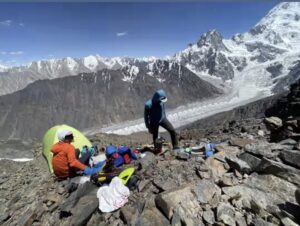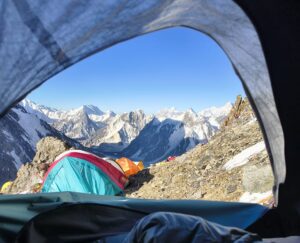Lakpa Sherpa, born in the village of Makalu 30 years ago, was the first climber to set foot on the summit of K2 this year. This was his third time on the top of K2. He has also summited Everest six times, Manaslu five times, Makalu twice, Lhotse once and a number of “Ama Dablams”.
Currently, he is preparing for an even more difficult adventure: the launch of his own outfitting company, 8K Expeditions.
Until recently, Lakpa was still the managing director of Pioneer Adventure, which led groups on K2 for the first time this year. The company managed to continue while bigger operators like Seven Summit Treks had to cancel their Pakistan season.
Pioneer led two teams. Lakpa partnered with Valentyn Sypavin’s Alpomania, while Mingma Dorchi Sherpa headed a Ukrainian team. They achieved a 100 percent summit success, with no injuries or rescues, and yet the venture was almost a no-go.
COVID uncertainty
By June, Pakistan had banned Nepali citizens from entering the country because of Nepal’s COVID flare-up. Buying tanks of O2 was also hard because of export restrictions in India. By the time the ban eased, most Nepal-based outfitters had already axed their summer. Somehow, Mingma Dorchi and Lakpa managed to hold their plans and clients together.
“To be honest, we were not sure if we would be able to organize the K2 expedition this year,” Lakpa admits. “We were in constant touch with our Pakistani agent (Summit Karakoram), keeping updated about all the minor details.
“Finally, the ban lifted with some conditions, but we still had to get a flight to Pakistan and to have everyone vaccinated. Once again we worked together, filing vaccination requests with the government. Thankfully, it was approved.”
Mountains far from home
It seems that Nepali climbers and guides should feel right at home in the Karakorum, but that’s not the case.
“For us, Pakistan is a foreign country, and going there feels totally different,” Lakpa said. “The major difference is lack of manpower. We have to work more and do everything by ourselves.”

Lakpa Sherpa atop K2. At left, Valentyn Sypavin. Photo: Lakpa Sherpa
On Everest, they have a larger team and more agencies to share the work.
“Also,” said Lakpa, “the weather on K2 may change in an instant, making the climb more challenging. Finally, carrying out rescue operations is also difficult in the Karakorum compared to the Himalaya.”
Roping up
This year, with all the delays, the Pioneer Adventure team arrived late at K2 Base Camp.
“We really appreciate that the local outfitter had already opened the route to Camp 2,” Lakpa said. “Our Sherpa team then fixed the ropes till few metres below Camp 3.”
When the weather turned bad, they returned to Base Camp for a few days. Then the Madison Mountaineering team continued the fixing until lower Camp 4.
“Both teams cooperated,” he said. “A few of us fixed from lower Camp 4 to higher Camp 4. Then both teams fixed the Bottleneck traverse. Finally, on July 27, our Sherpas fixed to the summit.”
Lakpa also noted that he and Valentyn Sypavin rearranged ropes between Camp 1 and Camp 3 “to make it look neat and easy for the climbers to follow.” [See attached photo of the spaghetti they initially dealt with.]
“We cut and set aside the old ropes used during previous expeditions, but sadly we couldn’t bring it down with us,” he said.

Lakpa Sherpa sorts out ropes between C1 and C2…

… and the final result. Photos: Lakpa Sherpa
The summit push
During the final push, Lakpa Sherpa was at the front of his team and was the first to step atop K2 this year.
“We set off at around 10 pm on July 26,” he said. “Sanu Sherpa, Chhiring Namgel Sherpa, and Pemba Rita Sherpa opened the route till the summit. They reached it around 7:30 am on July 27.” The clients summited two or three hours later.

Squint hard and you’ll see climbers traversing under the Great Serac, on top of the Bottleneck. Photo: Lakpa Sherpa
Needed: chances for young Pakistani climbers
Many Pakistani companies provide excellent Base Camp logistics but are not quite ready to operate fully serviced expeditions to the 8,000’ers.
“There isn’t any government mountaineering institution in Pakistan where a young, passionate guide can learn,” said Lakpa. “[In Nepal] we give young people a chance to learn from our experienced guides. Pakistani agencies can do the same by sending their guides with Sherpas or Western guides.”

Climbers traverse at night under the Great Serac. Photo: Lakpa Sherpa
Nepal’s fall season
In a few weeks, climbers return to Nepal for the fall season. However, the COVID situation has not changed since last spring. As Lakpa noted, the pandemic has hit the industry hard. But the trekking tours have suffered the most.
“Autumn is a great season for trekking, but it is difficult to organize treks with so many severe restrictions, especially quarantines. No one wants to quarantine for seven days to do a 14 to 20-day trek.
“This has caused many small trekking agencies to close. We have managed to survive because, besides treks, we organize longer expeditions.”
The Manaslu dilemma
Most outfitters are basically offering the same goals in September: Manaslu and Ama Dablam plus a “second try” at Dhaulagiri. A COVID outbreak in BC and high avalanche risk prematurely ended the spring attempts on Dhaulagiri.
As for Manaslu, the 8,163m peak has become an autumn favorite for 8,000m hunters, especially since China closed its borders, nullifying any attempts on Cho Oyu and Shishapangma.

Lakpa Sherpa on Ama Dablam. Photo: Lakpa Sherpa
However, controversy has surrounded Manaslu since it has become clear that almost everyone fails to reach the actual summit of the mountain. Inconveniently for mass mountaineering, it is located at the end of a picky, 20m-long, knife-edged ridge.
Winter K2 summiter Mingma G openly admits that “none of the commercial expeditions take clients to Manaslu’s main summit because of the tricky terrain.”
Mingma himself says that he has climbed Manaslu four times but has never stood on the true summit. This season, Mingma G and his Imagine Nepal company will try to deliver the real summit for the first time.
Says Lakpa Sherpa: “What Mingma G is trying to do is great, but who determines what is the real summit? I have summited Manaslu five times, and I believe thousands of other climbers have, too. If someone or some organization decides that…another point is the true summit, I am ready to lead my team there.”
But access to that summit involves technical challenges, especially fixing the entire section for what is often dozens of climbers. Each one will have to creep along that ridge and back, one at a time, certainly creating traffic jams.
“Before deciding whether to fix a single or a [two-way] rope, I need to see the ridge,” says Lakpa.
Crowding and risk
Pioneer Adventure and three other local outfitters achieved unprecedented summit success on Annapurna last spring. This involved airlifting oxygen cylinders and ropes to climbers in Camp 4, spreading out the camps to host larger numbers, and extensive use of O2. Some in the international mountain community fear that this extreme support may become a mainstay of commercial expeditions.
“At Annapurna last spring, there were many agencies with very few members,” Lakpa said. “We all cooperated in order to make a bigger group.”
For him, a large number of participants is “not an issue. It all comes down to proper planning and management. But if only one agency has a large number of clients for a particular mountain, they might find it hard to manage things properly.”





